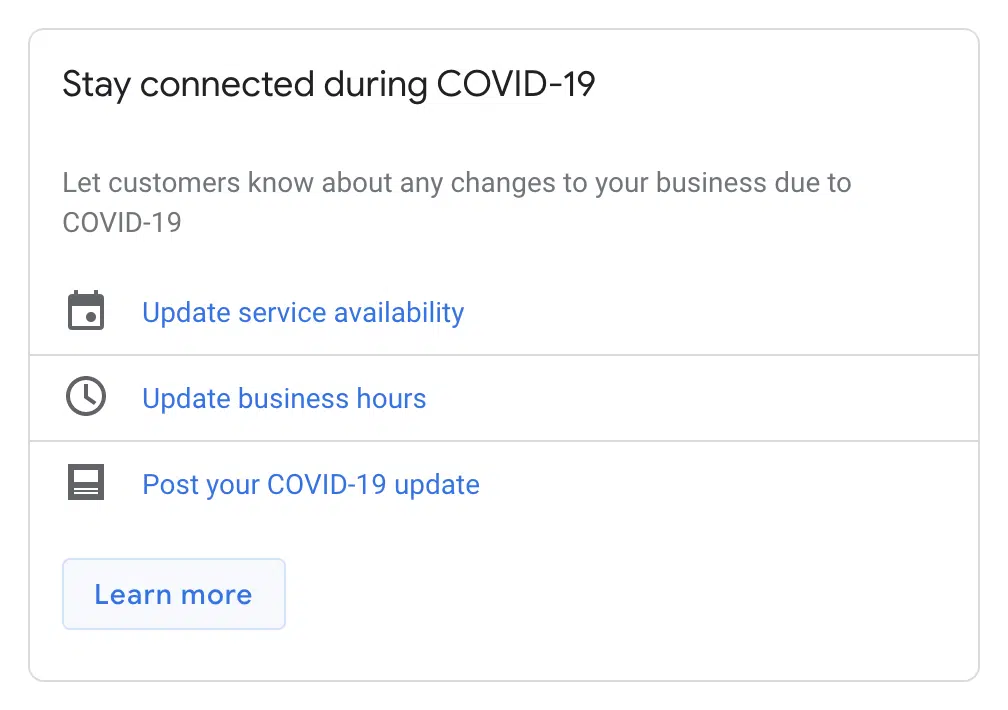It’s always a great time to make sure your local SEO practices are solid and consistent. If your business has changed at all in this past year, it might be time to revisit your Google My Business listing, local SEO citations and website content to make sure everything is accurate and accessible for users.
Since the pandemic shut down many local businesses (temporarily or permanently), it became convenient for people to turn to larger delivery and subscription services to satisfy their consumption needs. Many of the products and services that users sought pre-covid were once attainable by going down the street to a local corner store.
As a result of the prevalent conversations around supporting local shops it is safe to say that many folks have a stronger sense of how the businesses in their communities have been impacted. After seeing communities at their lows, consumers are ready to seek out more small, local businesses so we can all flourish as we re-enter “normalcy.”
Here are the topics covered in this post:
Implementing a well-rounded local SEO plan
Google My Business
One of the most important local SEO strategies for small businesses is to make sure your Google My Business (GMB) listing is accurate and current. The information on your business’ Google listing needs to match the business information on your website.
Think of the Google My Business listing as a snapshot of your website. You want to make sure users get a clear and consistent view of how your business is operating and what services you are offering.
NAP info
As always, it’s best practice to keep the business Name, Address and Phone number consistent across the web. This means that if your website uses STE 408, for the address suite details, don’t type Suite 408 in your address on your Google listing.
This goes for all local SEO citations. In most cases, if your Google listing does not match the address on your site at the time of set-up, your Google listing may not be verified.
Services
The GMB services are a great way to add more keywords to your Google listing while keeping users up-to-date on your offerings. If you’ve changed your business offerings then your Google listing services should reflect whatever your current services are.
Reviews
Reviews are a great way to emphasize the credibility of your business. It’s always a good idea to reply to reviews – regardless if they are positive or negative. Doing so shows users that your business is responsive and values customer input.
Attributes
If you’ve been managing your Google My Business listing during this past year, you’ve probably noticed some relevant and timely updates. Google released some new attributes about mask wearing, COVID testing, and sanitation so users can see which precautions businesses are taking as a result of the pandemic. Google has also included this resource in your listing dashboard for keeping customers updated about any changes to your business as a result of COVID.

Google attributes are a great way to let your customers know what they can expect when they enter your business. You can also add attributes to let users know more about business ownership and to signify inclusivity.
Here’s a list of common attributes that are available on GMB (they vary by business type):
- Family-Friendly/Welcomes Families
- LGBQT-Friendly
- Wheelchair Accessible Seating
- Wheelchair accessible restroom
- Staff wear masks
- Temperature check required
- No-contact delivery
- Curbside Pickup
- Takeout
- In-Store Pickup
- Delivery
- No-Contact Delivery
- In-Store Shopping
- Identifies as Black-owned
- Identifies as women-led
- See a full list here.
UTM parameters
If your Google listing is bringing users to a location page or a contact page, you can add campaign details to your website URL within your listing. Honestly, this is a good idea regardless of what page users are being brought to from the Google listing since it allows you to track visits to the site from your GMB.
Here’s a campaign url generator that allows you to enter in your campaign info and easily paste it into your Google My Business website field. It will look like this:
https://www.acoolwebsite.com/?utm_source=google&utm_medium=organic&utm_campaign=gmbHere’s an example you can refer back to when filling out the generator:

You could also set these for your Bing and Yahoo listings. Simply input the search engine in the “source” field so that you can tell the difference when you’re looking at your analytics.
Call tracking
Another helpful technique is to register for a call tracking service like Callrail. They will let you set up a separate phone number or groups of numbers so that you can more accurately see where your calls are coming from. The call tracking number will go in your phone number field of your GMB listing. With call tracking services you’ll also be able to manage all your phone call stats in one place to easily analyze stats and trends.
Paid ads
Local Service Ads
Local service ads (LSAs) are a fairly new addition to the Google search results page. LSAs are shown as boxes in the SERP that display links to your Google reviews, your service area, phone number and business hours. Also LSAs display a “Google screened” badge which makes your business stand out among the others.

For LSAs to be effective, you need to have a very high Google review score. Google strongly weights your rank in LSAs based on your Google review scores, no matter how much you are willing to spend. So if your review score is less than 4.5, LSAs probably aren’t the best option.
LSAs also have an extensive set-up process so if your review score isn’t where you’d like it to be, this may be something to consider.
Facebook Ads
When you’re determining what the best steps to take are to form your local SEO strategy, Facebook ads are definitely worth looking into. Facebook ads are a great way for local businesses to get connected with people in their community.
Creating a strong Facebook presence in general is something that many users can benefit from. It is somewhat of a norm for local businesses to have Facebook pages where they can post events, updates and interact with users. Facebook ads help you get your information to a wide range of potential clients and customers.
Also, it’s important to remember that you can sync your Facebook page with listings like Bing Local. So if your business info on Facebook is incorrect, it will also be incorrect on Bing and potentially other places across the web.
Website updates for local SEO
Consistent information
If you’ve moved locations or opened a new location, update your website accordingly. Google references your website as the standard for when it detects every mention of your business information so it’s extremely important that your website reflects the accurate business address, hours and services that are on your site.
Location pages
It’s considered best practice to also create location pages for every physical location your business has. However, if you have a large amount of physical locations, this can be a bit of a challenge to manage.
Check out our local SEO checklist for businesses with multiple locations.
When you create a new location page, you can also use this as your website link for that location’s Google My Business listing (with a UTM parameter attached).
On-page optimization for local SEO
Aside from making sure your NAP is correct on your site and Google listing, it’s important to keep in mind local SEO strategies when creating on-page content. Here are a few easy ways to optimize your pages for local SEO. This is not exclusive to just location pages.
- Geographic keywords in your titles, headings and copy. If you’re located in Chicago, a standard, yet effective heading example for your local SEO service page could be: “Top-Notch Local SEO Services in Chicago”
- Accessible location information on your site. It’s a good idea to link to your location page(s) from the footer or general contact forms and about pages.
- Address(es) in the footer! If you have a lot of locations, adding cities/service areas are also acceptable so that your footer won’t be crowded with addresses.
Local SEO citations
To supplement your other local SEO strategies, creating and monitoring local SEO citations is a great way to stay on top of your business information. As mentioned earlier, Google will reference your website against every mention of your business info so make sure there aren’t any incorrect citations that may cause conflicts and potentially confuse potential clients.
Tools like Brightlocal and Moz Local let you manage listings and they provide an overview of listings that need to be corrected. You can also find incorrect citations without management tools.
Finding incorrect/incomplete local SEO citations without a management tool
By using search techniques, you can navigate Google to find any citations that you need to update if your business information has changed, and it’s free.
Plug in your business info to the following equations in Google search and you’ll be able to weed through incorrect and incomplete citations.
To find incomplete NAP citations:
- “Correct business name” + “Correct business address” – “Correct business phone number”
- “Correct business name” + “Correct business phone number” – “Correct business address”
- “Correct business phone number” + “Correct business address” – “Correct business name”
To find incorrect NAP citations:
- “Correct business name” + “Correct business address” + “Old/incorrect phone number”
- “Correct business name” + “Correct phone number” + “Old/incorrect partial address”
- “Correct phone number” + “Correct partial address” + “Old business name”
In order to keep track of your changes, we recommend keeping all your citations in a spreadsheet.
Local SEO strategies that will last
These local SEO strategies are not exclusive to the current times we are living in. Even though technical and local SEO will continue evolving as Google rolls out new changes, there are many consistent ideas that we can depend on for our own local SEO tactics.
This transition towards “re-opening” further emphasizes users’ renewed willingness to support small businesses. Business owners are now given the opportunity to form strong local SEO practices to deliver correct, reliable information to people in their communities.




